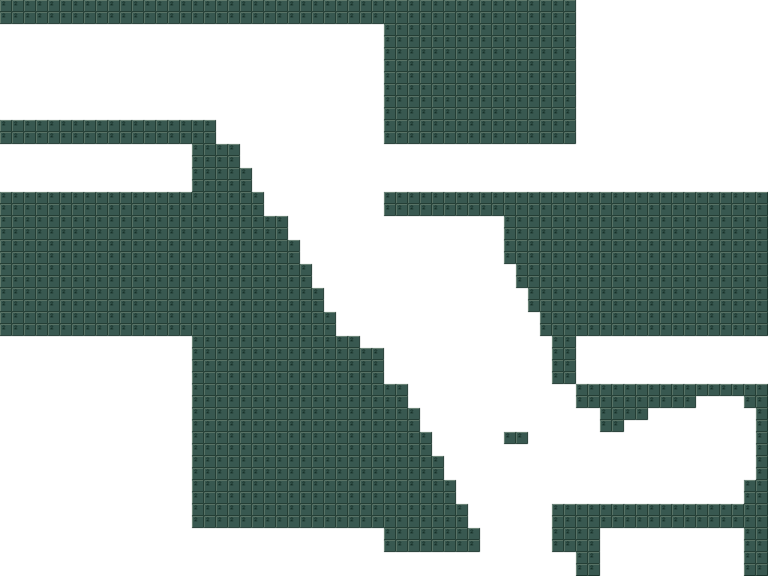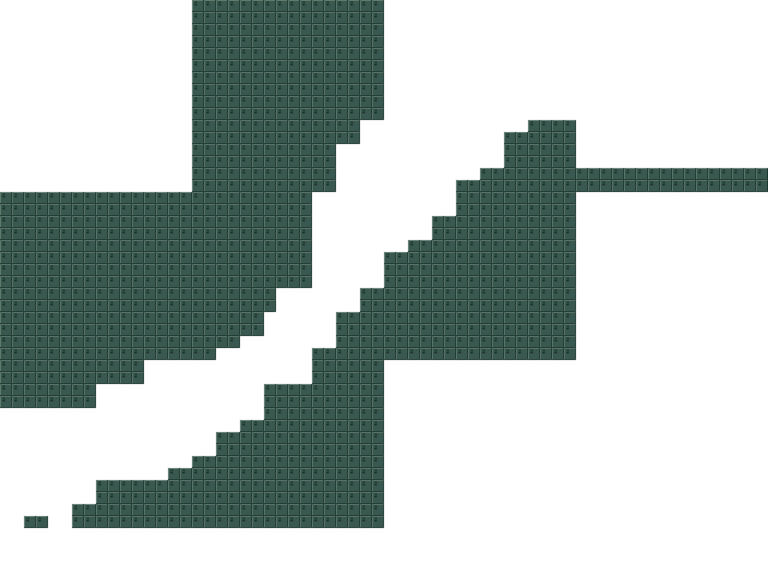Proto:The Legend of the Mystical Ninja/Stages 5 to 9
This is a sub-page of Proto:The Legend of the Mystical Ninja.
All stages past Stage 4 are not normally accessible in the prototype. Before starting a new game, enter and activate the Pro Action Replay (PAR) codes listed in each section to access the appropriate area. Be sure to deactivate the codes after entering.
Contents
Stage 5
Iga
PAR Codes
7E008204
7E008A03
While the layout of the stage has already been completed, all buildings and cave entrances lead to Minka 9 - a residence with a man who talks about the Otafuku Corps. In the final game, this dialogue comes from an old woman in Stage 4's Harima.
| Prototype |
|---|

|
| Final |

|
The background brightening continues unabated. In this case, it actually hurts the background a bit: The trees by the river in the valley look much worse against the brighter mountains.
| Prototype | Final |
|---|---|

|

|
The outermost tree leaves in the prototype are less densely packed and look slightly shaggier.
Ninja Mansion
PAR Codes
7E008204
7E008A04
Objects & Enemies
| Proto | Final |
|---|---|
The sword-wielding ninja has a unique face graphic in the prototype, while in the final game they use the same face as the kunai-throwing ninja.
Layout & Backgrounds
| Prototype | Final |
|---|---|
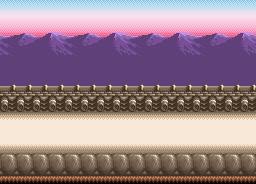 |
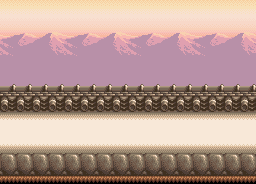 |
The prototype has a blue and pink sky and is either set at sunrise or sunset. The final game changes this to a more muted orange sunset scheme.
| Prototype | Final |
|---|---|
 |
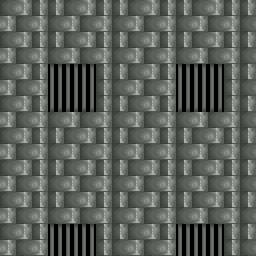 |
The color between the bars in the secret area's background is dark grey in the prototype and solid black in the final build.
| Prototype | Final |
|---|---|

|
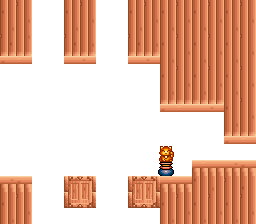
|
To make the place worth visiting, a golden maneki-neko was added to the end of the secret area at the beginning of the stage.
| Prototype |
|---|

|
| Final |

|
Whoever redid this area really liked crates: They replaced the platforms at the start, were used as a floor base, and three more were added to the bouncing ninja area. Two of the ropes (and rope ninja) were cut, possibly literally.
| Prototype | Final |
|---|---|
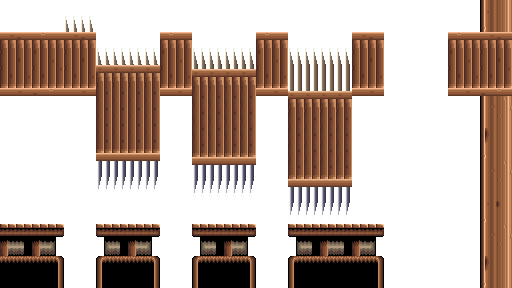
|
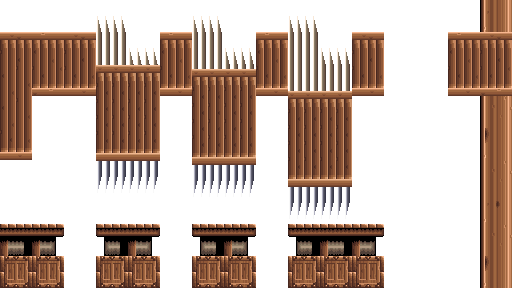
|
More crates, more spikes. It's possible to navigate the upper area without using the moving walls in the prototype, but not in the final game, which extended the leftmost spikes. A small set of spikes in the upper-left was removed.
| Prototype |
|---|
 |
| Final |
 |
To match the new sunset palette, the wooden background was brightened up.
| Prototype | Final |
|---|---|
 |
 |
In the bottom-left area of the second clacking balls section, there's a cubby that has a jar with a heart inside. Curiously, while this cubby is still in the final layout, there's nothing inside!
| Prototype |
|---|

|
| Final |
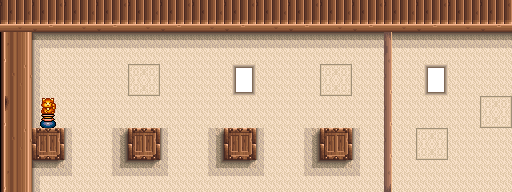
|
There are bars on the windows in the prototype, while the windows in the final game are too small to even need bars. The money chest was replaced by another golden maneki-neko.
| Prototype | Final |
|---|---|

|

|
While there's another golden maneki-neko-in-a-jar in the final version, the cubby in the final game extends further to the right to a more interesting place...

|
...a second secret area, one that was completely cut from the final game.
![]()
Players have to crawl through this opening section while avoiding these small, indestructible disc ninja and retracting spikes.

|
If players successfully get through the upper section by dealing with the rope ninja, they'll get access to something special: the prototype's only golden maneki-neko. Otherwise, they'll just have to dodge more retracting spikes.

|
Unlike the platforms on ropes in the first secret area, these platforms (and enemy) move on their own, back-and-forth, in perpetuity. The exit to this area is in the upper-left, and it leads directly to the boss.
| Prototype |
|---|

|
| Final |

|
While the path to the exit is fairly safe in the prototype, the final game is more treacherous. There are two more pits, with a window ninja next to each pit; one of the ninja on the right side was removed. Two more Oshizu-san enemies were placed before each set of pits. To make up for this, the final game adds yet another golden maneki-neko, though this one can only be accessed by using a flying jutsu.
| Prototype |
|---|
 |
| Final |
 |
Oh, here's the background for this section. Same changes as before.
Sasuke
| Prototype | Final |
|---|---|
 |
 |
Again with the sunset palette changes. The roof was changed from blue to pink to match the new time of day.
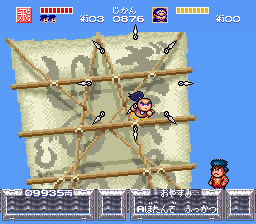
Sasuke's part of the fight is unfinished and is littered with bugs:
- The building's roof descends as the boss fight begins, same as in the final version, but it then pops back up shortly after going off-camera, ending up visible through the HUD.
- If the player hits Sasuke on the edge of the kite, he'll briefly fall down before teleporting back on the kite.
- The bottom of the screen is unstable; instead of acting as a pit, it will either bounce the players up or act as a platform.
- The screen doesn't transition after defeating Sasuke, leaving players stranded on the kite.
Ending
PAR Codes
7E008204
7E008A05
| Prototype | Final |
|---|---|
 |
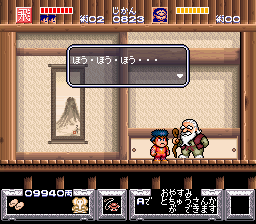 |
Instead of crashing in from the top of the screen, the player spawns in normally. The Wise Man cutscene is partly implemented, but the player has to manually initiate it by walking over to the left wall. The message window is too high, but other than that his dialogue has already been finalized. When Wise Man disappears, the player is transported to an out-of-bounds area in Tengu Mountains, where they will promptly die.
| Prototype | Final |
|---|---|

|

|
To save an 8x8 tile, one of Wise Man's feet was reduced in size.
| Prototype |
|---|

|
| Final |

|
While the end of stage cutscene doesn't seem to have been coded yet, the sprites for said cutscene have already been drawn and are loaded during the Wise Man cutscene. Some of the tiles used for the cane opening animation were cut to save more space, which is especially noticeable in the first and second frames, where the black outline from the cane in Wise Man's idle animation pokes out from the open cane.
| Proto | Final |
|---|---|
The cannon ninja gained black outlines around their eyes. The eyes in the prototype match the eyes of the other ninja in the stage, so it's not clear why this was done.
| Prototype | Final |
|---|---|

|

|

|
The cannon in the prototype has the lid of the cannon as separate sprites; it was probably planned for Goemon and Ebisumaru to enter the cannon during the cutscene instead of it starting with them already in the cannon. In the final game, the lid is part of the cannon graphic.
| Prototype | Final |
|---|---|
The smallest player sprites were squished to fit into a single 8x8 tile. This works great for Ebisumaru, but Goemon looks like he had his feet cut off.
Stage 6
Yamashiro
PAR Codes
7E008205
7E008A02
| Prototype |
|---|
 |
| Final |
 |
This town is in the roughest shape of all the towns so far: The graphics are rough, decorations are sparse, and the background nonexistent; there are no objects or enemies anywhere in the stage; building placement is preliminary and none of the buildings lead anywhere. At least the collision isn't borked like in Stage 4.
Like Stage 4, the prototype's tileset, for what it's worth, is unique to this stage; the final version uses the same tileset as Stage 1 and Tosa in Stage 2.
The prototype already allocates space to the bridge that appear in the same relative position in each area, though they're further to the left and much smaller than the bridges in the final game. The final version also eliminates some of the exits to make Yamashiro more labyrinthine: In this case, one of the northern exits and two of the southern exits were removed. The two buildings nearest to the bridge were deleted.
| Prototype |
|---|
 |
| Final |
 |
In the space south of the central area, two of the southern exits were removed, leaving only one exit to the southernmost area. This is the only area that has the same number of buildings between versions.
| Prototype |
|---|
 |
| Final |
 |
In the aforementioned southernmost area, one building was moved to the right of the bridge, and another was removed entirely.
| Prototype |
|---|
 |
| Final |
 |
In the space directly north of the central area, two of the buildings closest to the bridge were removed. Speaking of which, the impassible bridge in the final version seems to be represented here by a complete lack of a bridge. The final game removes the middle northern exit.
| Prototype |
|---|
 |
| Final |
 |
There are two small and one large building to the left of the bridge in the prototype - these were condensed into a single building with two entrances. There's a strange small building with no doorway in the prototype which might represent a planned secret entrance to an underground tunnel.
| Prototype | Final |
|---|---|
 |
 |
One building removed. The more important difference here is the entrance to Tengu Mountains. In the prototype, it's designed like a checkpoint building with an arrow pointing to the entrance, which fits better with the final game's Pass requirement. The final version uses a standard exit instead.
Tengu Mountains
PAR Codes
7E008205
7E008A03
Objects & Enemies
- The monkeys in this section are the only enemies with assigned sound effects.

|
- The prototype has a third type of tengu, one with a green head and a long spear. The red and green tengu spawn at the start, and the blue, leaf-throwing tengu appears last. In the final game, it was replaced with an additional red tengu.
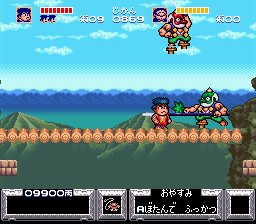
- In the prototype, the hurtboxes of both the spear and the red tengu's katana are displayed as leaves. The actual hurtbox of the spear is deceptively small.

- Cutting the green tengu freed up space in ROM and VRAM, and let the developers use its palette slot for a new flashing palette.
- The koi that appear in the waterfall section had their mechanics changed after the prototype:
-
- In the prototype, koi appear on the front side of the waterfall. They climb up the waterfall and try to maneuver over to the player; when they get close enough, they flop out at the player to damage them.
- In the final version, koi appear behind the waterfall and slowly home in on the player. They have no attacks, and can only hurt the player through contact damage.
| Proto | Final |
|---|---|
- Since they no longer appear in front of the waterfall, the ripple effect underneath the koi's sprite was no longer needed and was removed.
Layout & Backgrounds
| Prototype | Final |
|---|---|
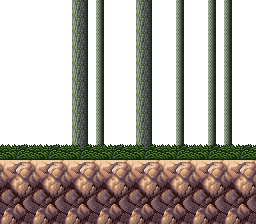 |
 |
The Tanuki room in the prototype has no background and a foreground with transparent elements. In order for the dialogue window in these rooms to have proper transparency, they have to be limited to a single background layer, so the setup here needed to be changed. The final version deletes the foreground trees and adds baked-in background graphics. The final layout is also extended vertically from 224 to 256 pixels, but this change doesn't seem to have fixed any particular bug.
| Prototype | Final |
|---|---|
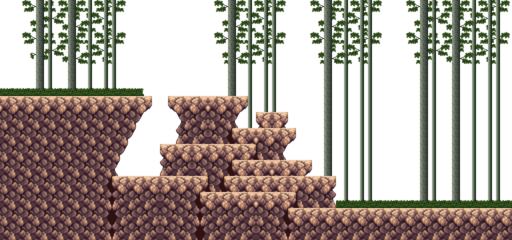 |
 |
There are more leaves on the third and fourth sets of trees -- the foliage in the prototype is barely visible unless the player uses a flying jutsu -- and a pot with a maneki-neko was placed below the large cliff on the left.
| Prototype | Final |
|---|---|
 |
 |
The final game gets rid of half of the trees in the prototype's way-too-busy background. The leaf graphics were redrawn and recolored to both add more depth to the trees and to better distinguish foreground from background. The trees are 40 pixels taller in the prototype, while the final game extends the clouds up by 32 pixels.
| Prototype |
|---|
 |
| Final |
 |
The biggest change in this area was an addition of a lower route, allowing the player to bypass the tengu mini-boss fight without using a flying jutsu. To accomplish this, another tengu-head tower was placed in the middle of the area. The towers themselves changed from an olivine color to more of a blue-gray. It's obvious in the prototype that the towers are mirrored horizontally; the final game obscures this by using unique tiles for the center of the towers. The second tower from the right is on top of a cliff in the prototype, while in the final game it's over a pit.
| Prototype |
|---|
 |
| Final |
 |
The final game adds two jars with both types of maneki-neko. To make the jar on the left accessible, the tengu head was flipped to the right. There are no bridge connectors in the prototype, leading to obvious gaps in the mountain. There are also two instances of platforms on the mountain being placed right next to each other, both of which were later removed. The bridge itself is just large enough to fill the screen in the prototype, while the final game makes it a tad wider.

If the player uses a flying jutsu to try to bypass the tengu fight, the camera will be locked so high up that when the jutsu runs out, the player will fall down and die in a "pit". The final game fixes this by locking the upper camera boundary of the stage just low enough for the bridge to be on-screen.
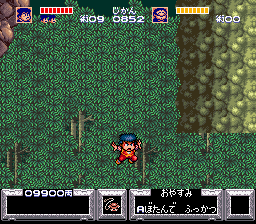
In a related oversight, the prototype doesn't adjust the lower camera boundary during the latter half of the stage, so the player is able to see where the foreground elements end.
| Prototype | Final |
|---|---|
 |
 |
The layout in front of the waterfall is pretty much the same minus a few openings in the rock walls and an extra platform at the entrance, but the terrain behind the waterfall is another story. Notably, the prototype lacks any platforms in front of the waterfall, only putting platforms behind the waterfall and a few platforms that switch between layers. The final version rearranges the platforms, doubles the number of layer-switching platforms in this area, and switches some platforms from behind the waterfall to in front of it.
The final version adds two monkeys to this area, three crabs behind the waterfall, and a checkpoint to the center of the area. The heart in the jar was replaced by a golden maneki-neko. Two of the monkeys were moved to the formerly empty bottom area.
| Prototype | Final |
|---|---|
 |
 |
The method that each version uses to achieve the transparent waterfall effect is different:
- The prototype puts the foreground on Layer 1 and a mask layer on Layer 2. This includes unique waterfall tiles that are overlaid on the rock walls and platforms - the platforms are marked with their collision ID, {{hex|1]}. The game then combines the two layers together. One notable failing in this method is that if the player is behind the waterfall and is standing on a floor that's in front of the waterfall, the player's feet will clip through the floor and out of the waterfall.
- In the final game, the waterfall is a single, unbroken layer without the unique rock wall / platform tiles; the developers were able to achieve the effect without them. This also allowed the developers to cut the special tiles used in the prototype, reducing the size of this area's tileset. However, this new method meant that the prototype's visual effect of making part of the right cliff appear behind the waterfall was no longer feasible.
| Prototype | Final |
|---|---|
 |
 |
The foreground graphics behind the waterfall were also changed. The prototype design of a black backdrop and yellow rocks can easily be seen behind the waterfall, while the blue rocks that the final game uses are nearly indiscernible.
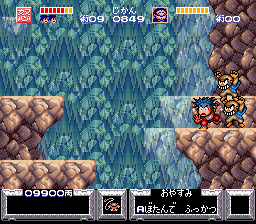
The monkeys on the bottom-right are placed right in front of the entrance. As soon as the player enters, they'll get hit and tumble into the pit below. The only way to bypass this is by using a jutsu before entering the area.

The waterfall layer gimmick in this area works, more or less, but there are a number of issues that were either fixed or changed in the final game:
- Players starts out behind the waterfall in the prototype, while in the final game they're more sensibly placed in front of the waterfall.
- When players are behind the waterfall, they're also able to freely move in and out of the waterfall area. The final game forces players to stay behind the waterfall area by making the cliffs on the left and right side of the area solid.
- Players can skip this entire section by simply walking off the left side of the screen. The final game adds an invisible wall running up the left side of the left cliff to prevent this.
- The rocks that move in-between the waterfall layers are buggy in the prototype, and will frequently drop the player down if players are standing on them as they're switching between layers.
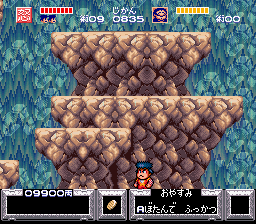
While the layout at the bottom of the stage is basically the same, the prototype has the lower camera boundary set too high. The player can stand on the lowermost platforms, but they're effectively invisible.
| Prototype | Final |
|---|---|
 |
 |
The final game adds two rock platforms on the bottom-left and top-right of this section of the waterfall. While the bottom-left set doesn't do much, the top-right platforms are a setup for another trap: If players jump to the right cliff and keep walking, they'll be transported back to the mountain section. Some other platforms were moved from behind to in front of the waterfall. The prototype makes the waterfall continue past the rock walls but lacks any kind of background. The final game adds background graphics to the foreground layer and cuts off the waterfall by adding foam tiles at the top.

The prototype has five statues hidden behind the waterfall. Since they would no longer be visible behind the brighter, more opaque waterfall, they were removed from the final version.
Kabuki
PAR Codes
7E008205
7E008A01
| Prototype |
|---|
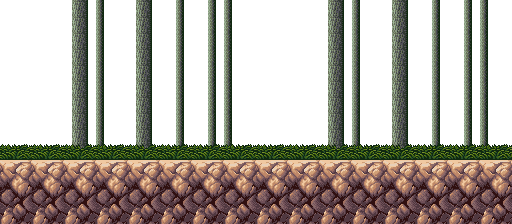 |
| Final |
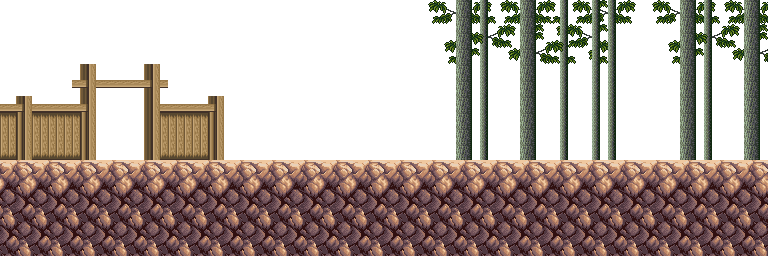 |
The prototype lacks the checkpoint gate at the end of the stage. The final game removes the grass and adds leaves to the trees.
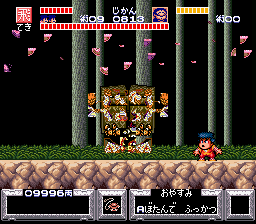
Kabuki is the first of three bosses in the prototype that don't have their sprites loaded correctly. In fact, the sprites for these bosses don't seem to be in the ROM at all! His flower box is actually a foreground object, so it is loaded and displayed correctly. There are a few other changes compared to the final game:
- Kabuki has no assigned sound effects for either phase.
- Kabuki's first phase doesn't have its own HP meter.
- Kabuki's second phase has one more HP in the prototype.
- There's no cutscene after defeating Kabuki in the prototype, though it will unlock the camera.
Stage 7
Izumo
PAR Codes
7E008206
7E008A01
| Prototype |
|---|
 |
| Final |
 |
Another rough outline of a city, though this one is a bit more complete than Stage 6. Enemies only spawn in this first section, and use Stage 1's enemy pack as a placeholder. No obstacles are in place, and none of the doors are functional.
| Prototype |
|---|
 |
| Final |
 |
While in the prototype Izumo has a tileset all its own, the tileset used in the final game is recycled from Harima in Stage 4, which itself was largely recycled from Stage 2; the unique wooden doors and colored curtains didn't make it to the final game.
| Prototype |
|---|
 |
| Final |
 |
Unlike stage 4 and 6, the number of buildings and their placement has already been decided, though some of the buildings were resized in the final game.
| Prototype |
|---|
 |
| Final |
 |
Not much here in the prototype other than the torii gate -- which is a brighter red in the prototype -- but at least the gate works.
Dragon Pond
PAR Codes
7E008206
7E008A00
Objects & Enemies
| Prototype | Final |
|---|---|
 |
 |
The bottoms of the big and small barrels throughout the stage use their own tiles in the prototype, while the final game uses the tiles from the tops of the barrels and flips them.
![]()
There are extra, unused frames for the green jumping fish that were later deleted.

In the prototype, Dragon Pond has a few more dragons living in it. These small pink dragons move in a simple wave-like motion and take a single hit to defeat.
![]()
![]()
Unused graphics suggest that this enemy was intended to be more complex than it is in the prototype, being able to turn around to track the player and breathe fire.

|

|
Another unused object is this large wave. The waves damage the player for 4 HP if hit from the side. Players can also jump on top of the waves to ride them, though there's not much point to this.
Layouts & Backgrounds

If accessed through the Tanuki room, the water layer will be incorrectly placed behind the foreground. Use the Pro Action Replay (PAR) codes above to warp directly to the stage proper, bypassing this glitch.
As for the Tanuki room itself, the only difference in it is that the background there isn't animated in the prototype.
| Prototype |
|---|
 |
| Final |
 |
There are no enemies in this section in the prototype. The final game adds six bomb-carrying hawks and a hermit crab, and gilds the maneki-neko.
| Prototype | Final |
|---|---|
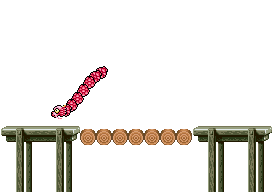 |
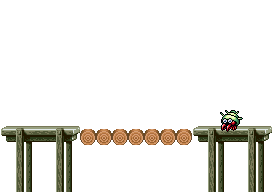 |
After the pink dragons were removed from the game, they had to place something here. They went with a hermit crab.
| Prototype | Final |
|---|---|
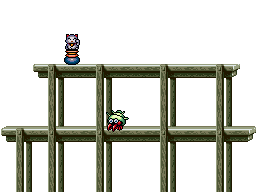 |
 |
Three more hermit crabs. Hermit crab fact: Some species can live over twenty years in captivity. These hermit crabs will live for around three seconds.
| Prototype | Final |
|---|---|
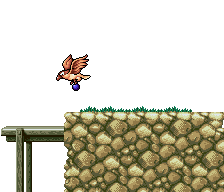 |
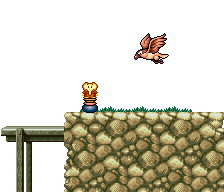 |
The final game added a checkpoint before the water wheel section, and removed the bomb from the talons of the hawk.
| Prototype |
|---|
 |
| Final |
 |
More replacements: The first bomb-carrying hawk replaced by three jumping fish, and the two pink dragons replaced by two more hawks. Midas touched the maneki-neko and then learned a valuable lesson about avarice.
| Prototype |
|---|

|
| Final |

|
In the prototype, waves continuously spawn in this area until the player reaches the end of the stage. After the waves were removed, three jumping fish were placed in-between the floating boards to provide some sort of challenge. The first jumping fish was replaced with another hermit crab, and three more enemies were added to the end of the stage.
Hakuryu
PAR Codes
7E008206
7E008A03
Hakuryu is partially implemented, but there are many differences and unfinished elements to the fight:
- Boss music doesn't play on this screen and a health meter isn't displayed.
- Like Kabuki, Hakuryu's sprites don't seem to be in the ROM, though the head is a foreground element and as such is loaded and displayed correctly.
- Hakuryu's body doesn't damage the player in the prototype.
- The prototype Hakuryu first shoots out a large (32x32 pixel) object before firing smaller projectiles. What this object is isn't exactly clear - like his neck, the graphics aren't in the ROM. This thing moves around in circles, targeting the player, and is completely indestructible. Up to two of these objects can be on-screen at a time.
- In the prototype, Hakuryu's head always stays in the same place when he fires at the player. In the final game, he's able to adjust his neck and head to shoot at the player from different heights.
- Hakuryu takes about 96 frames between shots in the prototype. In the final game, the delay was increased to 168 frames.
- If Hakuryu is hit as he's coming up from the bottom of the screen, he'll take damage and his animation will temporarily stop, but he'll continue to rise up anyway.
- After his HP is depleted, Hakuryu will continue attacking the player, players won't be able to hit his head anymore, and the game won't progress to the next screen.
Ending
PAR Codes
7E008206
7E008A04
| Prototype | Final |
|---|---|
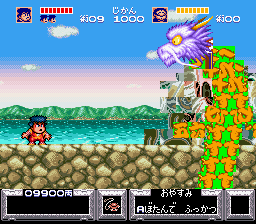 |
 |
As with Hakuryu, the sprites for the White Mirror shrine aren't loaded in and don't seem to be anywhere in the ROM. The prototype uses a friendly version of Hakuryu here instead of having the White Mirror talk. There's no dialogue yet and it's impossible to leave this screen.
Stage 8
Ryukyu
PAR Codes
7E008208
7E008A00
...it doesn't exist yet. Trying to access Ryuku will instead load the Shuri Castle side-scrolling area in top-down mode, which it, of course, isn't set up for. The player will eventually run into a near-impassible wall, and if they wiggle past it, they'll reach the camera bound and get stuck.
Shuri Castle
Tanuki Room - PAR Codes
7E008208
7E008A01

This should be the intro area, but the Tanuki statue isn't present. As a result, there's no way out of this room.
Area 1 - PAR Codes
7E008208
7E008A02
| Cut 1 |
|---|

|
| Cut 2 |

|
This stage is so different to the final version that comparing them directly would be pointless, with a tileset so rudimentary that it's hard to tell if it would even have the same theme. Said tileset helpfully labels every block with its collision ID: Solid blocks are 2, left slopes are 3 and 4, and right slopes are 6 and 7.
The stage starts out with a long, flat section with a few small branches. Like the cut hidden area in the Ninja Castle, crawling is mandatory, which as a concept isn't used at all in the final game. Taking the upper path in the second section is impossible without a flying jutsu - there may have been some kind of sprite-based platform planned to be placed in the gap.
The flat section continues on for a bit more. Halfway through this section is a hole in the ceiling that might correspond to the holes that drop the rolling Daruma enemies in the final game.
Next comes a very large drop that leads to what looks to be the prototype's equivalent of the Daruma Otoshi mini-boss arena. Again, there were probably plans to put sprite-based platforms in this area, which would make the jump to the boss area much easier. There seems to be a separate path to a secret room in the upper-right, though what would be placed in there is a totally mystery.

As soon as the camera locks on the right side of the area (no matter where the player is vertically, so it will trigger even if the player is in the secret area) the player will be falling down a large pit. This is the clearest connection to the final game, which features a drop of identical length that leads to an auto-scrolling vehicle section.

This first 256x256 chunk is repeated five times in the prototype. While the final game uses a functionally identical chunk for the entire fall, the prototype does something more interesting...
| Cut 1 | Cut 2 | Cut 3 | Cut 4 |
|---|---|---|---|

|
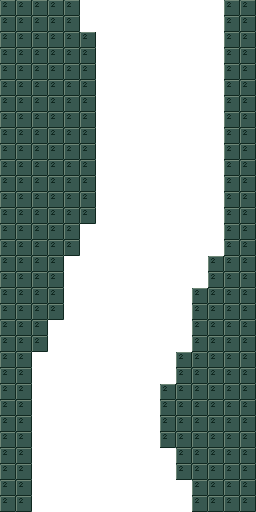
|

|

|
...where the pit bends, splits, and narrows as players fall through it. Colliding with the sides of the pit just bounces the player off, but there may have been plans for the player to take collision damage. Otherwise, there isn't really much point other than making the fall more visually interesting.
| Cut 1 |
|---|

|
| Cut 2 |

|
In contrast to the previously mentioned vehicle section mentioned previously, the prototype has another largely unspectacular platforming section. This time there's bottomless pits!
After getting through the previous section, the player has to slowly jump out of the pit. The flat area on the right would likely lead to a boss area.
Area 2 - PAR Codes
7E008208
7E008A03
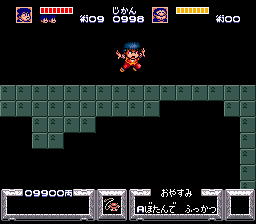
Spawns players in the "secret" room in the upper-right corner of the stage, which results in them automatically going into the falling section. From there, the layout is identical to Area 1.
Area 3 - PAR Codes
7E008208
7E008A04

Uses the chunks from cut 4 of the long falling section. Slowly scrolls downward for 704 pixels and exits into a pit, though the only way to survive all the way to the end is to use a flying jutsu. Might be a precursor to the elevator section in the final game, though that one scrolls upwards.
Boss
PAR Codes
7E008208
7E008A05

General Hannya must have taken a wrong turn somewhere, because he's supposed to be in Stage 9. Like Kabuki and Hakuryu, the foreground-based elements (the karajishi) load correctly, while the sprites for General Hannya don't seem to be in the ROM anywhere. An obvious placeholder arena is used here.
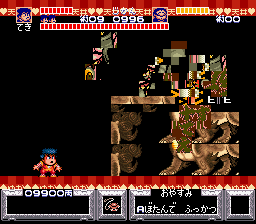
While the karajishi is put together properly at the start, its tilemap gets corrupted as soon as the stage finished fading in. The first part of the fight is mechanically similar to the final game, though General Hannya only shoots one arrow at a time instead of three arrows at once, and players can also attack the karajishi directly in addition to hitting it with arrows.

After defeating the karajishi, General Hannya jumps to the ground, waits for a bit, then jumps back up. At this point, the boss fight resets back to the first phase.
| Proto (Used) | Proto (Fixed) | Final |
|---|---|---|

|

|

|
While General Hannya's riding sprites don't seem to exist yet, his other sprites do. The spinning sprite clearly features General Hannya curled up into a ball, while the final version is more abstract. The spinning seems to be incorrectly assembled in-game in the prototype: One of the frames is duplicated, and while the tiles for the right-facing frame are correctly flipped horizontally, they should need to be flipped vertically.
| Prototype | Final |
|---|---|

|

|
While in the final game it's obvious that the actual General Hannya is a short human man wearing a mask, the prototype design is a bit more puzzling, looking like a miniature version of the General Hannya robot.
Stage 9
Dungeon
PAR Codes
7E008209
7E008A00
| Prototype | Final |
|---|---|
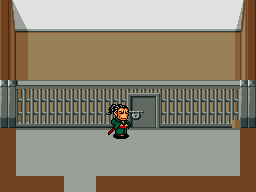 |
 |
The prototype has a rough sketch of the final tileset, with detailed cell bars and single-color floors and walls. In the prototype, one of the samurai enemies from Stage 1 frees the players, while in the final game it's Yae who opens the cell. The breakable wall that leads to the side-scrolling area is not in the prototype.
| Prototype |
|---|
 |
| Final |
 |
The wooden elements in this area are more detailed than the single-color floors and walls, but not by much. A different approach to the prison cells in this stage between version: In the prototype, the cells are populated with NPCs from the town stages, but they can't be interacted with; In the final game the cells are empty, but the cell doors act like building entrances.

The cell bars are high-priority tiles in the prototype. This works for making it seem like the NPCs are behind bars, but not so much for Goemon and Ebisumaru.
![]()
There are frequent sprite and HUD visibility bugs in the prison sections. It's not clear what's causing this, but it's either the enemies in this section being improperly configured or some issue with the code related to putting the NPCs behind bars.
| Prototype |
|---|
 |
| Final |
 |
The first two cellshave doors placed all the way to the left. In the final game, the doors for each cell are placed as close to the center as possible. The final game adds a southern exit...
...that leads to a new filled with useful shops.
| Prototype | Final |
|---|---|
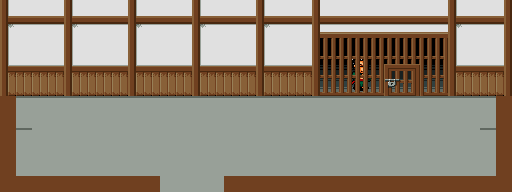 |
 |
The cell door was moved 32 pixels to the left. Standard stuff.
Edo
PAR Codes
7E008209
7E008A02
Objects & Enemies
This stage seems to be a testing ground of sorts for potential enemies and hazards. Enemy graphics are represented by maneki-neko statues and koban coins.

The first runs back and forth on the ground, tracking the player. They'll occasionally stop and toss out coins in a narrow arc that explode on impact.

The second type hides behind the roofs of buildings. After a bit, they'll peek out and toss a coin straight left or right.

A deleted hazard are these large rolling balls. While initially inert, they'll start moving when the player either strikes or runs into them. They have proper slope physics, slowly rising on inclines and then rolling back down, though they'll pass through any walls in their way.
Layout & Backgrounds
| Prototype |
|---|

|
| Final |

|
Both versions start out in a tunnel with destructible blocks, but the tunnel is over twice as long in the prototype. The three-tiered section was removed completely, as was the lone enemy in-between sections.
The graphics used in this section are primitive, but they impart the theme well enough. The tunnel walls are in the roughest state, appearing only as 32x32 black squares with a single 8x8 transparent tile in the bottom-left.
| Prototype |
|---|

|
| Final |

|
Compared to the opening tunnel, the building graphics are remarkably close to being finalized. The ground's another story, though. The layout here is similar to the final version's, though the prototype is missing the bamboo spike pit.
| Prototype |
|---|

|
| Final |

|
The final version almost doubles this section in length by adding four more buildings and a wooden outpost on the left. The green post on the right does appear in the prototype, it was just moved to the next section.
| Prototype |
|---|

|
| Final |

|
The only change in layout here is the building's placement: While centered in the prototype, it was moved more to the right in the final version to make room for Yae and a checkpoint. Like Shuri Castle, the slope graphics here are labelled with collision IDs.
| Prototype (Cut 1) |
|---|

|
| Prototype (Cut 2) |

|
From the previous area, the prototype includes a long underground section featuring three tiers of platforms and a swarm of enemies. The maneki-neko are stand-in for the lantern-throwing enemies found in the final game, while the koban coins (which rapidly change between coins and cats) don't have a final game equivalent. This entire section was removed from the final version.
| Prototype | Final |
|---|---|

|

|
Here's where the underground section ends. It's impossible to make it across the gap without a flying jutsu, but there's not much on the other side anyways. The final game instead continues upwards...

|
...where the player has to navigate up a billow of clouds and reach the floating castle above.
Bosses
PAR Codes
7E008209
7E008A04 (No Daruma), 7E008A05 (Daruma)
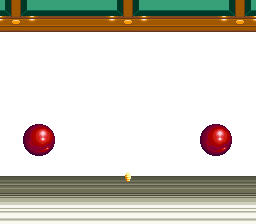

These are test rooms for the Yajirobee Daruma boss of Stage 8. One room only has the Daruma's hands, while the other contains the entire boss. Take note that the floor and ceiling -- which have graphics don't match any room in the final game -- are not solid, so the player will have to use a flying jutsu immediately after entering to avoid dying.
The boss gently tilts left and right while its hands move up and down. At this point in development it's not possible to hit the boss, so this is more of a motion test than anything else. The coin in the center of the room can be hit, though doing so will not accomplish anything.
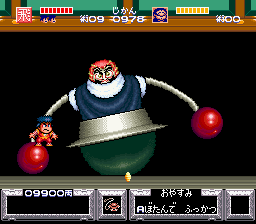
The player can stand on the Daruma's hands in the prototype, though this is fairly buggy and will result in the player fidgeting up and down as the hands move. This feature was later removed...
| Prototype | Final |
|---|---|

|

|
...and to keep the player from trying, its fists changed from red orbs to grey spike balls. The Daruma head's eyes were enlarged and its mustache dyed blue to better match the design of the Stage 8 miniboss.
PAR Codes
7E008209
7E008A06
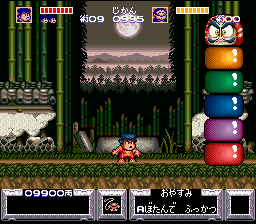
Speaking of which, the Daruma Otoshi has its own test room in the prototype. For whatever reason, it uses the Stage 1 boss arena. The boss is much closer to completion than Yajirobee Daruma, though it has a couple of mechanics changes:
- Each segment takes five hits in the prototype, later reduced to just three hits in the final game.
- When the boss is defeated, it slides off to the right, damaging and potentially killing the player if they're in its path. The final game fixes by making it fly up and off the screen.
The boss is also missing sound effects for everything but the segments dropping down.



